An intangible cultural heritage is the manifestation of traditional cultures inherited by generations of different nationalities. Containing profound cultural connotations, the intangible cultural heritages imply the creativity and aesthetic concept of different nationalities, so they are important, inseparable part of a certain culture.
One of China's historical and cultural cities first promulgated in 1982, Kunming as the capital city of Yunnan province called home by the largest number of ethnic groups in China is such a place where different ethnic cultures melt together.
With rich, distinctive ethnic culture resources, Kunming has as many as 500 items of intangible cultural heritages of different levels. During the 2016 Cherry Flowers Festival (to last till the end of March) of Yuantong Mt (Kunming Zoo), a small domed building is opened to public displaying the most typical intangible cultural heritages of Kunming.
1-Yi ethnic costumes of Luquan
.jpg) The Yi people in Luquan County inherit a fascinating tradition for making costumes and embroideries in a very big variety, including dresses, satchels, pillow covers, quilt covers, baby carriers, sofa covers, curtains and many other embroidered decorations. Patterns of these works are highlighted by traditional auspicious plants and animals such as peony flowers, plum blossoms, tigers, eagles, dragons, magpies and butterflies etc.
The Yi people in Luquan County inherit a fascinating tradition for making costumes and embroideries in a very big variety, including dresses, satchels, pillow covers, quilt covers, baby carriers, sofa covers, curtains and many other embroidered decorations. Patterns of these works are highlighted by traditional auspicious plants and animals such as peony flowers, plum blossoms, tigers, eagles, dragons, magpies and butterflies etc.
.jpg) These patterns carry different meanings in the Yi ethnic culture. For example, dragon, tiger and eagle on the coats of Yi ethnic men are the Yi ethnic totems; the sheep horns on the lapels of the Yi ethnic ladies means "life goes well"; the pomegranates on the baby carrier symbolise fertility; and the Rhododendron-flowers-like hats imply the pursuit of a good life.
These patterns carry different meanings in the Yi ethnic culture. For example, dragon, tiger and eagle on the coats of Yi ethnic men are the Yi ethnic totems; the sheep horns on the lapels of the Yi ethnic ladies means "life goes well"; the pomegranates on the baby carrier symbolise fertility; and the Rhododendron-flowers-like hats imply the pursuit of a good life.
2-Yunnan style snuff bottles
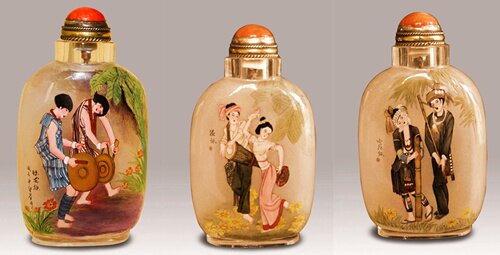 As the most important part of the snuff bottle techniques, the history of inner painting can date back to the Qianlong Period of the Qing Dynasty. Highlighted by the Yunnan’s natural landscapes, cultural facts, and ethnic customs, a Yunnan style snuff bottle is more than a snuff bottle in itself.
As the most important part of the snuff bottle techniques, the history of inner painting can date back to the Qianlong Period of the Qing Dynasty. Highlighted by the Yunnan’s natural landscapes, cultural facts, and ethnic customs, a Yunnan style snuff bottle is more than a snuff bottle in itself.
3-Jiama paintings of Jinning
.jpg) Jiama is a kind of painting traditionally used in sacrificial ceremonies such as funerals, religious services and exorcising activities etc. In Kunming, Jiama paintings mainly prevail in Jincheng Town and Kunyang Town of Jinning County at the southern bank of Dianchi Lake.
Jiama is a kind of painting traditionally used in sacrificial ceremonies such as funerals, religious services and exorcising activities etc. In Kunming, Jiama paintings mainly prevail in Jincheng Town and Kunyang Town of Jinning County at the southern bank of Dianchi Lake.
4-Wood carvings of Yiliang
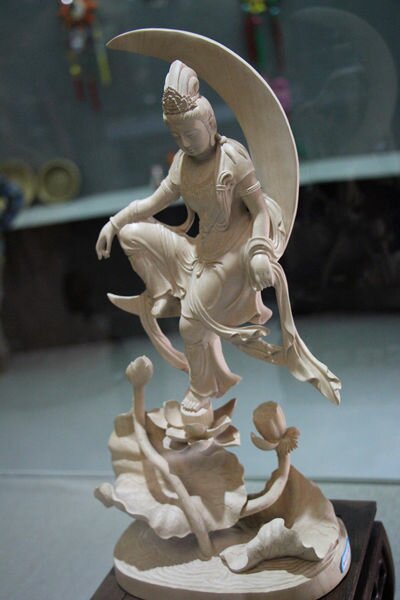
The massive immigration of the Han nationality from the 1360s to 1390s laid a firm foundation for the introduction of Central China's agricultural civilisation and traditional culture to Yiliang that was then known as "Granary in Central Yunnan". The wood carving of Yiliang was gradually developed in such a historical background.
The wood carvings of Yiliang are mainly used as architecture decorations, furniture, and housed items. The most reputed prolific artisan is Mr Gao Zhiyong whose exquisite works like The Boat of Zheng He are fascinating.
5-White potteries of Yiliang
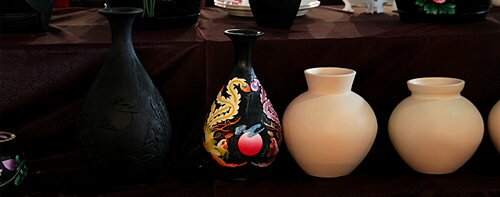 A village named Yaoshangcun of Majie Town (Yiliang County) is famed for its special clay resources. Local villagers have kept the centuries-old kilning technique from their forefathers. The potteries appear white, smooth, and feature fine texture. Also practical, they are rare handcrafts worthy of housing.
A village named Yaoshangcun of Majie Town (Yiliang County) is famed for its special clay resources. Local villagers have kept the centuries-old kilning technique from their forefathers. The potteries appear white, smooth, and feature fine texture. Also practical, they are rare handcrafts worthy of housing.
6-Yunnan style kites
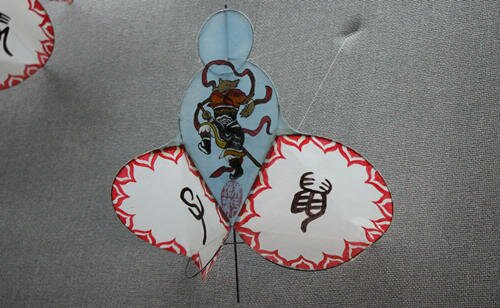
The history of Yunnan style kites is somewhat intricate. During the immigration of the Han nationality to Yunnan in the Yuan and Ming dynasties, the North China's kite techniques were introduced. Local craftsmen cleverly mastered the technique catering to local climate of Yunnan.
7-Dough sculptures of Songming

The dough sculpture is an outstanding traditional technique of Songming County as well as one of the province-level intangible cultural heritages of Yunnan.
This kind of cute handicraft is made from glutinous rice and assorted colours, undergoing the major process of kneading. According to the demand of clients, the dough can be vividly shaped into trees, mountains, animals, people, fruits, vegetables and whatever you want.
8-Copper-silver artefacts of Guandu
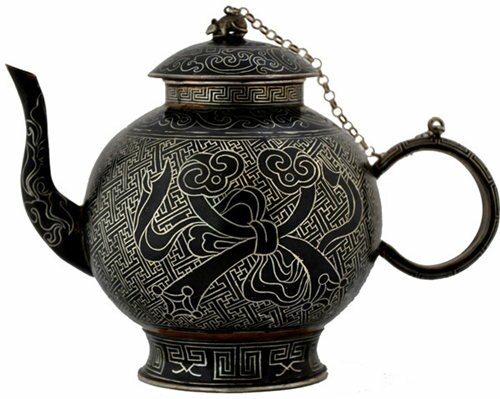
Locally called "Wu Tong Zou Yin", this kind of precious handicraft is a Han ethnic technique first innovated in Shiping County in the south of Yunnan province, and also traditional in Guandu of Kunming.
The major part of a copper-silver artefact is copper on which different intaglios are engraved. Craftsmen infuse melted silver (or gold) into the intaglios and then polish the whole masterpiece. As time goes by, the copper turns black, highlighting the silver or gold in a quaint manner. The locals vividly call this kind of gorgeous technique "Wu Tong Zou Yin" which means "silver walks on black copper".
9-Yunnan bornite artefacts
The history of bornite artefact technique can date back 300 years. It is said that at the beginning, craftsmen in Dongchuan of Kunming and Huize of Qujing forged the natural bornite ores into utensils and traded to Kunming where local coppersmiths reprocessed them into artefacts.
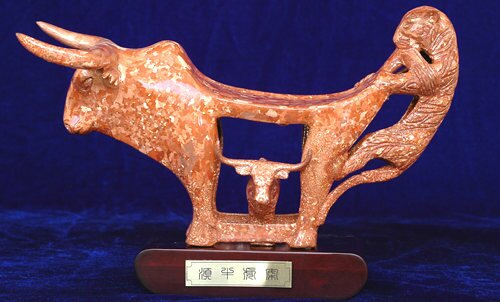 The bornite artefacts appear quaint and vary in models including people, animals, flowers, incense burner, jars, wall decors and containers etc. The most famous two works are the Ox-Tiger Table and the Peacock Jar.
The bornite artefacts appear quaint and vary in models including people, animals, flowers, incense burner, jars, wall decors and containers etc. The most famous two works are the Ox-Tiger Table and the Peacock Jar.
10-Yunnan chessmen
 Yunnan chessmen were originally produced in the ancient Yongchang prefecture (current Baoshan city) in the west of Yunnan province, which is why Yunnan chessmen are also called "Yong Zi". In the Ming and Qing dynasties, Yong Zi was listed as articles of tribute. When Queen Elizabeth visited Kunming in 1985, Yunnan Provincial Government presented her a set of Yunnan chessmen.
Yunnan chessmen were originally produced in the ancient Yongchang prefecture (current Baoshan city) in the west of Yunnan province, which is why Yunnan chessmen are also called "Yong Zi". In the Ming and Qing dynasties, Yong Zi was listed as articles of tribute. When Queen Elizabeth visited Kunming in 1985, Yunnan Provincial Government presented her a set of Yunnan chessmen.
11-Tile cats of Xiaoyao Village
 Tile cats are talismans set on roofs of buildings. They are mythically believed to be able to invite fortune and keep off misfortune. The history of the technique of tile cats in Xiaoyao Village (Panlong District) can date back to the Ming and Qing dynasties.
Tile cats are talismans set on roofs of buildings. They are mythically believed to be able to invite fortune and keep off misfortune. The history of the technique of tile cats in Xiaoyao Village (Panlong District) can date back to the Ming and Qing dynasties.